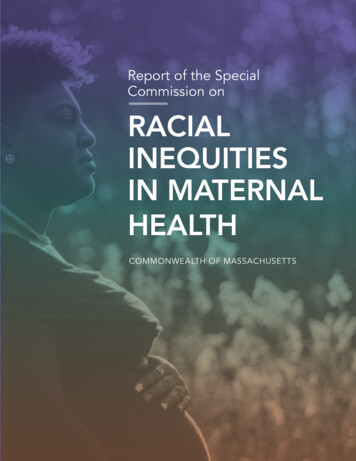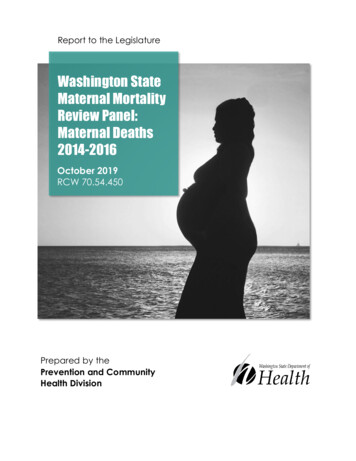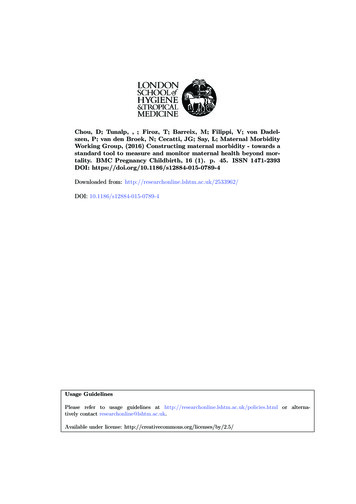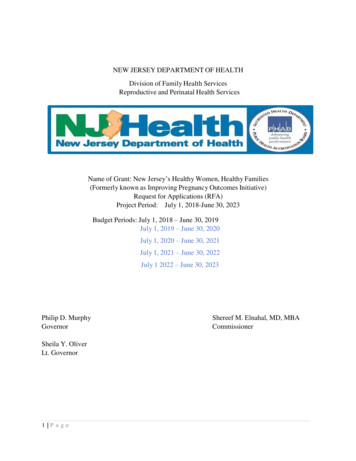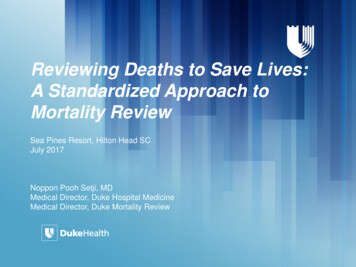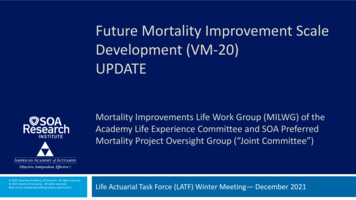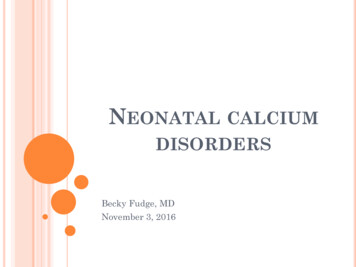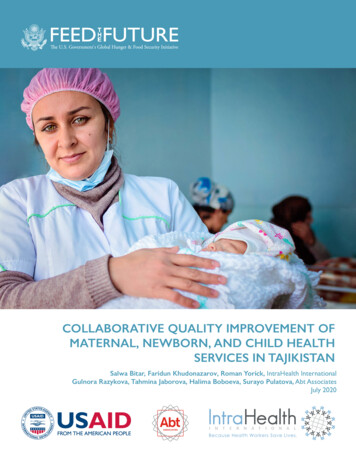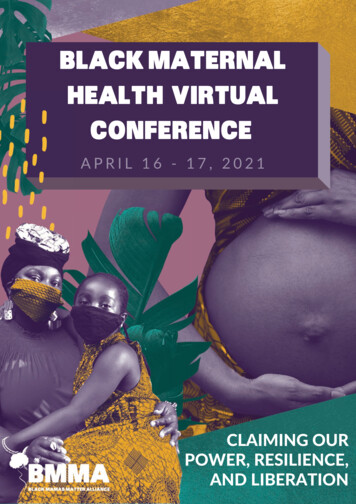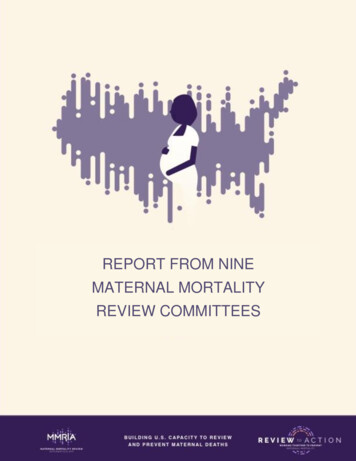
Transcription
REPORT FROM NINEMATERNAL MORTALITYREVIEW COMMITTEES
AcknowledgementsWe, the Project Team behind Building U.S. Capacity to Review and Prevent Maternal Deaths, would like to thank thefollowing groups for their integral role in conducting maternal mortality review and for providing data to this report: theColorado Maternal Mortality Review Committee, Delaware Maternal Mortality Review, Georgia Maternal MortalityReview Committee, Hawaii Maternal Mortality Review Committee, Illinois Maternal Mortality Review Committee, NorthCarolina Maternal Mortality Review Committee, Ohio Pregnancy Associated Mortality Review, South Carolina MaternalMorbidity and Mortality Review Committee, Utah Perinatal Mortality Review Program, and the Virginia MaternalMortality Review Team.We would also like to acknowledge the Emory University Rollins School of Public Health and the Association forMaternal & Child Health Programs (AMCHP) for their partnership in the development of this report.We would like to acknowledge the CDC, CDC Foundation, and consulting staff who significantly contributedto the report:Mary D. Brantley, MPHJean Ko, PhDDivision of Reproductive HealthCenters for Disease Control and PreventionDivision of Reproductive HealthCenters for Disease Control and PreventionWilliam Callaghan, MD, MPHMichael Kramer, MMSc, PhDDivision of Reproductive HealthRollins School of Public HealthCenters for Disease Control and PreventionEmory UniversityAndria Cornell, MSPHElena Kuklina, PhDWomen’s & Infant Health ProgramAssociation of Maternal & Child Health ProgramsDivision of Reproductive HealthCenters for Disease Control and PreventionShanna Cox, MSPHKristin Liu, MPHDivision of Reproductive HealthCenters for Disease Control and PreventionRollins School of Public HealthEmory UniversityNicole Davis, MPH, PhDKathryn Mishkin, MPH, MADivision of Reproductive HealthRollins School of Public HealthCenters for Disease Control and PreventionEmory UniversitySarah Foster, MPHAmy St. Pierre, MBADivision of Reproductive HealthCenters for Disease Control and PreventionBuilding U.S. Capacity to Review and Prevent MaternalDeathsCDC FoundationDavid Goodman, MS, PhDDivision of Reproductive HealthCenters for Disease Control and PreventionAndrea Strahan, DrPH CandidateRollins School of Public HealthEmory UniversitySarah Haight, MPHDivision of Reproductive HealthAvae Thomas, MPHCenters for Disease Control and PreventionRollins School of Public HealthEmory UniversityKendra Hatfield-Timajchy, PhDDivision of Reproductive HealthCenters for Disease Control and PreventionJulie Zaharatos, MPHBuilding U.S. Capacity to Review and Prevent MaternalDeathsCDC Foundation
We would also like to acknowledge the following members of the National Partnership to EliminatePreventable Maternal Mortality for their careful review of the report:Angela Aina, MPHChristi Mackie, MPHBlack Mamas Matter AllianceAssociation of State and Territorial Health OfficialsDeborah Burch, MSN, RNJeanne Mahoney, RN, BSNDivision of NursingThomas UniversityAmerican College of Obstetricians and GynecologistsElliott Main, MDJoia Crear-Perry, MD, MPHCalifornia Maternal Quality Care CollaborativeBlack Mamas Matter AllianceTorri Metz, MDAlexander Crosby, MD, MPHUniversity of Colorado School of MedicineDivision of Violence PreventionCenters for Disease Control and PreventionCatherine Ruhl, MS, CNMEugene Declercq, PhDAssociation of Women’s Health, Obstetrics, and NeonatalNursesDepartment of Community Health SciencesBoston University School of Public HealthCarol Sakala, PhD, MSPHChildbirth Connection ProgramsRobyn D’Oria, MA, RNC, APNNational Partnership for Women and FamiliesCentral New Jersey Family Health ConsortiumNeel Shah, MD, MPHKarin Downs, RN, MPHBureau of Family Health and NutritionAriadne LabsHarvard Medical SchoolMassachusetts Department of Public HealthCynthia Shellhaas, MD, MPHStacie Geller, PhDCenter for Research on Women and GenderUniversity of Illinois at ChicagoDivision of Maternal-Fetal MedicineThe Ohio State University Medical CenterCaroline Stampfel, MPHLisa Hollier, MD, MPHAssociation for Maternal & Child Health ProgramsAmerican College of Obstetricians and GynecologistsEleni Tsigas, BATina Johnson, CNM, MSPreeclampsia FoundationAmerican College of Nurse MidwivesCatherine Vladutiu, PhD, MPHAbby Koch, MA, PhD CandidateCenter for Research on Women and GenderMaternal and Child Health BureauHealth Resources and Services AdministrationUniversity of Illinois at ChicagoLisa Waddell, MD, MPHMichael Lu, MD, MS, MPHMarch of DimesMilken Institute School of Public HealthThe George Washington UniversityThomas Westover, MDDepartment of Maternal-Fetal MedicineThe Cooper Health SystemThis project was supported by funding from Merck through an award agreement with its Merck for Mothers Program.Suggested citation: Building U.S. Capacity to Review and Prevent Maternal Deaths. (2018). Report from nine maternalmortality review committees. Retrieved from http://reviewtoaction.org/Report from Nine MMRCs
Report from Nine Maternal Mortality Review Committees 5ContentsExecutive Summary . 6Preface . 7Introduction To Maternal Mortality Review Committees . 9The Data. 12Question 1: Was the Death Pregnancy-Related? . 14Question 2: What Was the Cause of Death? . 16Question 3: Was the Death Preventable? . 22Question 4: What Were the Factors that Contributed to this Death? . 24Question 5: What Are the Recommendations and Actions That Address Those Contributing Factors? 29Question 6: What Is the Anticipated Impact of Those Actions If Implemented? . 31Data Summary . 35Emerging Issues . 37Maternal Mental Health Conditions – an Update . 37Severe Maternal Morbidity Review . 42Incorporating Equity – an Update . 47Summary . 55Appendix A: Maternal Mortality Review Committee Decisions Form. 57Appendix B: Underlying Cause of Death Regroupings . 62Appendix C: Contributing Factors by Leading Causes of Death . 63Appendix D: Recommendations for Action with Select Examples . 70References . 72
Report from Nine Maternal Mortality Review Committees 6Executive SummaryApproximately 700 women across the United States (U.S.) die each year as a result of pregnancy orpregnancy-related complications. Non-Hispanic black women experience maternal deaths at a rate threeto four times that of non-Hispanic white women, a racial disparity that is mirrored across many maternaland infant outcomes. While surveillance using vital statistics can tell us about trends and disparities, stateand local maternal mortality review committees (MMRC) are best positioned to comprehensively assessmaternal deaths and identify opportunities for prevention. The Maternal Mortality Review InformationApplication (MMRIA) and its precursor, the Maternal Mortality Review Data System (MMRDS), assistMMRCs in abstracting relevant data from a diversity of sources, documenting committee decisions for eachreviewed maternal death, and analyzing data for action. Using data from nine MMRCs (hereafter, the NineCommittees), this updated and expanded report includes—for the first time—recommendations forprevention, discussion of severe maternal morbidity review, and novel work on a MMRIA socio-spatialdashboard to incorporate health equity into MMRC discussions.Nearly 50% of all pregnancy-related deaths were caused by hemorrhage, cardiovascular and coronaryconditions, cardiomyopathy, or infection. The leading underlying causes of death varied by race.Preeclampsia and eclampsia, and embolism were leading underlying causes of death among non-Hispanicblack women. Over a three-year period, the United Kingdom had only two deaths from preeclampsia andeclampsia, suggesting deaths from these hypertensive disorders of pregnancy are highly preventable.Mental health conditions were a leading underlying cause of death among non-Hispanic white women,reinforcing the value of MMRCs including mental health-related maternal deaths in the scope of their review,and having access to information beyond death certificates.The Nine Committees estimated that over 60% of pregnancy-related deaths were preventable. The mostcommon factors identified as contributing to the death were patient/family factors (e.g., lack of knowledgeon warning signs and need to seek care) followed by provider (e.g., misdiagnosis and ineffectivetreatments) and systems of care factors (e.g., lack of coordination between providers). While the NineCommittees most commonly identified patient factors, the patient factors identified are often dependent onproviders and systems of care. For the first time, the Nine Committees provided analyzablerecommendations to prevent future maternal deaths and the estimated level of potential impact if thoserecommendations were implemented. The following were the most common recommendation themes thatthe Nine Committees also estimated to have the largest potential for population-level impact if implemented:adopting levels of maternal care, improving policies regarding prevention initiatives, enforcing policies andprocedures related to obstetric hemorrhage, and improving policies related to patient management. Socialand environmental factors may also contribute to a woman’s risk of dying during or within one year ofpregnancy. MMRCs can incorporate contextual social determinants of health into case discussions, andtranslate findings into specific recommendations. This report is a demonstration of MMRCs’ potential toaddress health equity as a strategy to reduce maternal mortality and severe maternal morbidity.To turn the tide on maternal mortality in the U.S. we must build on current momentum and support thecritical work of MMRCs. State- and local-level MMRCs can be the gold standard for understanding whypreventable maternal deaths continue to occur and to prioritize ways to effectively reduce maternal deaths.As more MMRCs are able to share data, there will be greater understanding and specificity of potential highimpact recommendations. These recommendations for action will be beneficial for public health and clinicalcare decision-makers as they design strategies to eliminate preventable maternal deaths at the local, state,regional and national levels. Describing recommendations for each of the leading causes of death is animportant step forward; determining the potential of a recommendation to prevent maternal deaths remainsan important opportunity for the future.
Report from Nine Maternal Mortality Review Committees 7PrefaceThe data used in this report are made possible by a partnership with nine states that have been supportingthe development of the Maternal Mortality Review Data System (MMRDS) and/or the Maternal MortalityReview Information Application (MMRIA): Colorado, Delaware, Georgia, Hawaii, Illinois, North Carolina,Ohio, South Carolina, and Utah. While this report reflects data from the nine states, MMRIA is a reflectionof lessons learned from implementing MMRDS or MMRIA in a total of 20 state and local MMRCs. The longterm engagement with these MMRCs has benefited us all through rich mutual learning. Through thedevelopment of this report, we have come to understand the mechanics of combining and using data frommultiple MMRCs. We have also identified opportunities for improvement and future possibilities as moreMMRCs collaborate.As of January 1, 2018, the Building U.S. Capacity to Review and Prevent Maternal Deaths team (hereafter,project team) has responded to 48 jurisdictions (42 states, five cities and one U.S. territory) requestingMMRIA and other MMRC support tools. These jurisdictions, representing approximately 92% of U.S.maternal deaths, are listed below.1.Alabama Dept. of Public Health25.Montana Dept. of Public Health & Human Services2.Alaska Maternal & Child Death Review26.Nebraska Dept. of Health & Human Services3.Arizona Dept. of Health Services27.Nevada Dept. of Health & Human Services4.Arkansas Dept. of Health28.New Hampshire Dept. of Health & Human Services5.Colorado Dept. of Public Health & Environment29.New Jersey Central Jersey Family Health Coalition6.Connecticut Dept. of Public Health30.New Mexico Dept.of Health7.Delaware Child Death Review Commission31.New York City Dept. of Health & Mental Hygiene8.District of Columbia Dept. of Health32.North Carolina Dept. of Health & Human Services9.Florida Dept. of Health33.Ohio Dept. of Health10.Georgia Maternal Mortality Review34.Oklahoma State Dept. of Health11.Hawaii Dept. of Health35.Oregon Health Authority12.Illinois Dept. of Public Health36.Pennsylvania Dept. of Health13.Indiana State Dept. of Health37.Philadelphia Dept. of Public Health14.Iowa Dept. of Public Health38.Puerto Rico Dept.of Health15.Kansas Dept. of Health & Environment39.San Antonio (TX) Metropolitan Health District16.Kentucky Dept. for Public Health40.South Carolina Dept. of Health and Environmental Control17.Los Angeles County Public Health41.Tennessee Dept. of Health18.Louisiana Bureau of Family Health42.Texas Dept. of State Health Services19.Maryland Dept. of Health & Mental Hygiene43.Utah Dept. of Health20.Massachusetts Dept. of Public Health44.Virginia Dept. of Health21.Michigan Dept. of Health & Human Services45.Washington Dept. of Health22.Minnesota Dept. of Health46.West Virginia Bureau for Public Health23.Mississippi State Dept. of Health47.Wisconsin Dept. of Health Services24.Missouri Dept. of Health & Senior Services48.Wyoming Dept. of Health
Report from Nine Maternal Mortality Review Committees 8The project team partnered with eight MMRCs to develop a logic model that outlines the requirements forcreating a fully functional MMRC (Figure A). MMRIA provides an opportunity for MMRCs to achieveprocess requirements such as collecting data, producing case summaries, and providing reports usingrobust data; the content of MMRIA was developed with these requirements in mind.Figure A. Logic Model for Creating a Fully-Functional Maternal Mortality Review CommitteeBeyond MMRIA, the project team developed resources and provided focused onsite and distance-basedtechnical assistance to address specific challenges MMRCs experience. States have unique needs rangingfrom too few cases for annual reporting, to so many cases that it is difficult to find sufficient resources toinitiate a review. For smaller states, the project team encourages interstate collaborative use of MMRC dataat the regional level to add power to their analyses and prevention actions; for larger states, the team isexploring opportunities for intrastate collaboration by local reviews.The tools developed and the technical assistance provided, coupled with refined MMRIA content andongoing efforts to make data consistent, all support the effective and efficient implementation of MMRCs.MMRIA provides a shared data framework that empowers MMRC prevention activities. The U.S. can bestsave lives and prevent harm with thoughtful and strategic practices that honor unique contexts and needsat the state and local levels, while simultaneously adopting a cohesive approach that leverages all the datawe collect on maternal deaths. MMRIA also provides support to reviews that take on emerging issues—such as maternal suicide, drug overdose, and intimate partner violence—in the form of scientific- andpractice-based resources and tools. This report is a recognition of our common commitment to eliminatingpreventable maternal deaths and reducing disparities. We can only fulfill our commitment by workingtogether.
Report from Nine Maternal Mortality Review Committees 9Introduction To Maternal Mortality ReviewCommitteesThere are two national sources for trends and information on maternal deaths using vital statistics data(Table 1). The first, the National Center for Health Statistics (NCHS), uses death certificate information toassign ICD-10 codes that are used to identify maternal deaths and produce a maternal mortality rate (i.e.,maternal deaths while pregnant or within 42 days postpartum per 100,000 live births). The second, thePregnancy Mortality Surveillance System (PMSS), uses death certificates that show a relationship topregnancy identified by either a checkbox on the death certificate or by a linked birth or fetal death certificateregistered in the year preceding death. Medical epidemiologists review this information to identifypregnancy-related deaths and produce a pregnancy-related mortality ratio (i.e., pregnancy-related deathswhile pregnant or within a year postpartum per 100,000 live births).A reliance on vital statistics alone to measure maternal mortality makes it challenging to determine whetherchanges observed are the result of improved identification of maternal deaths or changes in the risk.[1, 2]While surveillance using vital statistics can tell us about trends and disparities, state- and local-basedMMRCs are best positioned to comprehensively assess maternal deaths and identify opportunities forprevention.[3, 4]Table 1. National Sources of Maternal Mortality Information*CDC – National Center for Health StatisticsCDC – Pregnancy Mortality Surveillance System (PMSS)†DATA SOURCEDEATH CERTIFICATESDEATH CERTIFICATES LINKED TO FETAL DEATH ANDBIRTH CERTIFICATESTime FrameDuring pregnancy – 42 days postpartumDuring pregnancy – 365 days postpartumSource ofclassificationInternational Classification of Diseases, 10th revision(ICD-10) codesMedical epidemiologists assign PMSS codesTermsMaternal death Pregnancy-associated death, (Associated and) Pregnancy-related death, Associated but not pregnancy-related deathMeasureMaternal mortality rate:Pregnancy-related mortality ratio:# of maternal deaths# of pregnancy-related deathsper 100,000 live birthsper 100,000 live birthsPurposeShow national trends and provide a basis forinternational comparisonAnalyze clinical factors associated with deaths, publishinformation that may lead to prevention strategiesStrengths Best source of historical data (back to 1900)Most clinically relevant national measure of the burden ofmaternal deaths Reliable basis for international comparison Based on readily available data (death certificates)Challenges Constrained by ICD-10 codes Constrained by information available on death and birthcertificates Lacks sufficient detail to inform preventionstrategies Lacks detailed information on contributors to deaths* Adapted from St. Pierre et al, 2017. linfanthealth/pmss.html
Report from Nine Maternal Mortality Review Committees 10The foundation for case identification by most MMRCs is linking death certificates to birth certificates orfetal death records, an approach that is consistent with PMSS. However, MMRCs have access to additionalinformation on maternal deaths, such as medical and social records, that allow a deeper examination of theprocesses and factors leading to the death than what is possible from vital registration information alone.Beyond assessing preventability, MMRCs make recommendations, promote, and increasingly implement,effective population-based prevention activities.Members of MMRCs typically represent public health, obstetrics and gynecology, maternal-fetal medicine,nursing, midwifery, forensic pathology, mental health, and behavioral health. Members might also includesocial workers, patient advocates, and other relevant, multidisciplinary stakeholders. Through a partnershipbetween the MMRC, the state vital records office, and epidemiologists, deaths among women ofreproductive age are examined to determine if they occurred during pregnancy or within a year of the endof pregnancy (pregnancy-associated deaths). Through this process, potential cases of pregnancy-relateddeaths are then identified.Death certificates may indicate a pregnancy-associated death through a pregnancy checkbox or a causeof death code related to pregnancy. By themselves, however, death certificates are not sufficient tocomprehensively identify all pregnancy-associated deaths. To further identify pregnancy-associateddeaths, a routine linkage should be conducted between all death certificates of reproductive-aged womenwith infant birth or fetal death records for the year preceding death. When pregnancy-associated deathsare identified from death certificates alone, a representative of vital records or the MMRC may need toconfirm that the death occurred during pregnancy or within one year of the end of pregnancy.Some MMRCs have additional protocols for identifying pregnancy-associated deaths, such as linkages tohospital discharge data, direct hospital reporting, media reports, or obituary searches. All identified casesare sent to a MMRC representative to be entered into a database. Sources of case information may includebirth and death certificate data, prenatal care records, hospital records, autopsy reports, informantinterview, and social services records. Abstractors distill relevant information from these sources anddevelop committee review materials, including a case narrative, for each case. MMRCs then convene todiscuss the cases.There are six key decisions MMRCs make for each death reviewed:1.2.3.4.5.6.Was the death pregnancy-related?What was the underlying cause of death?Was the death preventable?What were the factors that contributed to the death?What are the recommendations and actions that address those contributing factors?What is the anticipated impact of those actions if implemented?While all six questions are essential, the last four questions highlight the unique and critical role of MMRCs:preventability, contributing factors, recommendations for improvement, and measurement of potential forimpact. The analyses included in this 2018 report cover all six questions, two of which overlap with PMSS,and four of which are unique to MMRCs.
Report from Nine Maternal Mortality Review Committees 12The DataStructureNine state-based MMRCs—Colorado, Delaware, Georgia, Hawaii, Illinois, North Carolina, Ohio, SouthCarolina, and Utah—contributed data to this report. These states have been entering data into eitherMMRIA (released in 2017) or its precursor, MMRDS. MMRIA is a custom application and MMRDS is adatabase built on the Centers for Disease Control and Prevention’s (CDC’s) publicly available Epi Info software version 7.1.5.2. There are 11 forms in MMRDS and 12 forms in MMRIA. For each maternal death,there is one form for abstracting information from the death certificate, autopsy report, birth certificate(parent section), prenatal care record, social and environmental profile, mental health profile (MMRIA only),case narrative (MMRIA only), and ultimately the committee decisions. There may be more than one of thefollowing forms completed for a given maternal death: birth certificate (infant or fetal death section),emergency room visits and hospitalizations, other medical office visits, medical transports (MMRIA only),and informant interviews. We anticipate all states that used MMRDS in 2017 will transition to MMRIA in2018.Within many of the forms, there are one or more grids for data entry that may be used to store a list ofrelevant information, such as vital signs or laboratory tests. For example, within the autopsy report form,there are four grids: gross findings, microscopic findings, causes of death, and toxicology. Grids containmultiple data fields that relate to a common event or finding. For example, the toxicology grid from theautopsy report contains fields for substance, concentration, unit of measure and comments.YearsYears of deaths included in these analyses vary between the Nine eorgia2012—2014Hawaii2015Illinois2015North Carolina2014—2015Ohio2008—2015South Carolina2014—2017Utah2014Rather than report trends in pregnancy-related mortality over time, our overarching focus in this report is todemonstrate the use of standardized MMRC data for understanding preventability, factors that contributeto deaths, and best opportunities for reducing pregnancy-related deaths; thus, the variation in yearsbetween states is not a barrier to the collective use of these data. As more MMRCs use MMRIA and areable to share data, it may be possible to look at both the most current and the overall data.Race and ethnicityWhere possible throughout the report, we present findings by race-ethnicity, age, and timing of death. Whilerace and ethnicity are captured in the data set just as they are recorded on the source documents, and
Report from Nine Maternal Mortality Review Committees 13recoded consistent with Office of Management and Budget Race and Ethnic Standards for FederalStatistics and Administrative Reporting[6], available data did not support analysis beyond non-Hispanicwhite, non-Hispanic black and Hispanic groupings. In the future, with more MMRCs contributing data, wemay be able to describe deaths by additional race and ethnicity categories. We used race and ethnicitydata from the birth certificate when available and from death certificates when a birth certificate wasunavailable, based on evidence that the birth certificate is a more reliable source of data on race andethnicity.[7]Age at deathUsing information from death certificates, age at death is captured as a continuous variable in the data set.For the purposes of analysis, we grouped age at death into six categories: Younger than 20 years20-24 years25-29 years30-34 years35-44 years45 years and olderTiming of death in relation to pregnancyThe timing of a woman’s death in relation to pregnancy is captured in two ways. Death certificates capturethe relationship of death to pregnancy through a pregnancy checkbox. Standard checkbox options, asspecified by the National Center for Health Statistics, are:If female: Not pregnant within past yearPregnant at time of deathNot pregnant, but pregnant within 42 days of deathNot pregnant, but pregnant 43 days to 1 year before deathUnknown if pregnant within the past yearIn addition, when a death certificate links to a birth or fetal death record, then the number of days betweendeath and the end of pregnancy is calculated within MMRDS/MMRIA. We grouped this continuous variableinto categories consistent with the death certificate checkbox options. When this information was missingor unknown, we used timing information on the death certificate checkbox.Data cleaningData from the Nine Committees were cleaned to ensure that only valid observations remained for analysis.In addition, four duplicate entries were identified and removed.We present the following analyses of the Nine Committee data in six sections, corresponding to each of thesix key decisions that MMRCs make. Within each section, the project team provides background anddefinitions, a description of the results of the Nine Committee analyses specific to that question, and adiscussion of how we are moving forward to better understand opportunities for preventing pregnancyrelated deaths.
Report from Nine Maternal Mortality Review Committees 14Question 1: Was the Death Pregnancy-Related?Background and definitionsThe first decision a committee makes is whether a death was pregnancy-related.Pregnancy-associated deaths include all deaths that have a temporal relationship to pregnancy but notnecessarily a causal relationship to pregnancy. Within the universe of pregnancy-associated deaths arepregnancy-related deaths. Pregnancy-related deaths refer to the death of a pregnant or postpartum womanas a result of her pregnancy. MMRCs start ascertaining pregnancy-related deaths by casting the widest netpossible, identifying all deaths among women with any evidence of pregnancy in the year before death (i.e.pregnancy-associated deaths). A subset of these may be determined to be pregnancy-related deaths —deaths causally related to pregnancy or its management that occur during pregnancy or within a year of theend of a pregnancy (i.e., abortion, live birth, fetal or infant death).MMRCs document their decision on pregnancy-relatedness using the following four categories: Pregnancy-related: The death of a woman during pregnancy or within one year of the e
Division of Nursing Thomas University Joia Crear-Perry, MD, MPH Black Mamas Matter Alliance . The Ohio State University Medical Center Caroline Stampfel, MPH Association for Maternal & Child Health Programs . (e.g., lack of knowledge on warning signs and need to seek care) followed by provider (e.g., misdiagnosis and ineffective .
